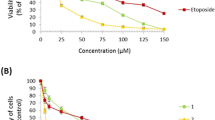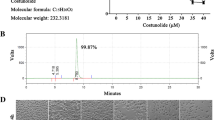Abstract
In the present study effect of 7-H-pyrrolo[2,3-d]pyrimidine derivative (7-HPPD) on viability of MKN28 and MKN74 gastric cancer cells was investigated. There was no significant change in GES-1 cell viability on treatment with 7-HPPD for 48 h. MKN28 and MKN74 cell viability was reduced to 21 and 23%, respectively, on treatment with 7-HPPD at concentration of 50 µM. Hoechst 33342 staining showed that the cells treated with 7-HPPD showed condensation of chromatin material, presence of apoptotic bodies and intense blue fluorescence. Treatment of MKN28 and MKN74 cells with 7-HPPD markedly increased the release of LDH. Z-VAD-FMK prevented 7-HPPD-induced suppression of MKN28 and MKN74 cell viability. Exposure to 15, 20, 25, 30 and 50 µM concentrations of 7-HPPD caused concentration-based increase in caspase-8, -9, -3 and cleaved PARP. A significant increase in ROS production was caused by 7-HPPD in MKN28 and MKN74 cells. Increasing the concentration of 7-HPPD from 10 to 50 µM did not increase the expression of RIP3 protein. In summary, 7-HPPD suppresses gastric cancer cell growth by inducing apoptosis through increase in caspase expression and ROS production. Consequently, 7-HPPD may be used for the development of treatment strategy for gastric cancer.








Similar content being viewed by others
Change history
09 February 2023
This article has been retracted. Please see the Retraction Notice for more detail: https://doi.org/10.1007/s13205-023-03504-3
References
Ahamed M, Akhtar MJ, Siddiqui MA, Ahmad J, Musarrat J, Al-Khedhairy AA, AlSalhi MS, Alrokayan SA (2011) Oxidative stress mediated apoptosis induced by nickel ferrite nanoparticles in cultured A549 cells. Toxicology 283:101–108
Chen H, Li Y, Zhu Y, Wu L, Meng J, Lin N, Yang D, Li M, Ding W, Tong X, Su Q (2017) Advanced glycation end products promote ChREBP expression and cell proliferation in liver cancer cells by increasing reactive oxygen species. Medicine (Baltimore) 96:e7456
Dai ZJ, Gao J, Ji ZZ, Wang XJ, Ren HT, Liu XX, Wu WY, Kang HF, Guan HT (2009) Matrine induces apoptosis in gastric carcinoma cells via alteration of Fas/FasL and activation of caspase-3. J Ethnopharmacol 123:91–96
Eckert A, Keil U, Marques CA, Bonert A, Frey C, Schüssel K, Müller WE (2003) Mitochondrial dysfunction, apoptotic cell death, and Alzheimer’s disease. Biochem Pharmacol 66:1627–1634
Forman HJ, Maiorino M, Ursini F (2010) Signaling functions of reactive oxygen species. Biochemistry 49:835–842
Hikita H, Kodama T, Shimizu S, Li W, Shigekawa M, Tanaka S, Hosui A, Miyagi T, Tatsumi T, Kanto T et al (2012) Bak deficiency inhibits liver carcinogenesis: a causal link between apoptosis and carcinogenesis. J Hepatol 57:92–100
Hu C, Song G, Zhang B, Liu Z, Chen R, Zhang H, Hu T (2012) Intestinal metabolite compound K of panaxoside inhibits the growth of gastric carcinoma by augmenting apoptosis via Bid-mediated mitochondrial pathway. J Cell Mol Med 16:96–106
Huang P, Zhang YH, Zheng XW, Liu YJ, Zhang H, Fang L, Zhang YW, Yang C, Islam K, Wang C, Naranmandura H (2017) Phenylarsine oxide (PAO) induces apoptosis in HepG2 cells via ROS-mediated mitochondria and ER-stress dependent signaling pathways. Metallomics 9:1756–1764
Ji YB, Qu ZY, Zou X (2011) Juglone-induced apoptosis in human gastric cancer SGC-7901 cells via the mitochondrial pathway. Exp Toxicol Pathol 63:69–78
Kodera Y, Fujiwara M, Koike M, Nakao A (2006) Chemotherapy as a component of multimodal therapy for gastric carcinoma. World J Gastroenterol 12:2000–2005
Lee Y, Sung B, Kang YJ, Kim DH, Jang JY, Hwang SY, Kim M, Lim HS, Yoon JH, Chung HY, Kim ND (2014) Apigenin-induced apoptosis is enhanced by inhibition of autophagy formation in HCT116 human colon cancer cells. Int J Oncol 44:1599–1606
Liu X, Li Y, Peng S, Yu X, Li W, Shi F, Luo X, Tang M, Tan Z, Bode AM, Cao Y (2018) Epstein–Barr virus encoded latent membrane protein 1 suppresses necroptosis through targeting RIPK1/3 ubiquitination. Cell Death Dis 9:53. https://doi.org/10.1038/s41419-017-0081-9
MacKenzie SH, Clark AC (2012) Death by caspase dimerization. Adv Exp Med Biol 747:55–73
Manda G, Isvoranu G, Comanescu MV, Manea A, Debelec Butuner B, Korkmaz KS (2015) The redox biology network in cancer pathophysiology and therapeutics. Redox Biol 5:347–357
Parkin DM, Bray F, Ferlay J, Pisani P (2005) Global cancer statistics, 2002. CA Cancer J Clin 55:74–108
Su X, Wang P, Yang S, Zhang K, Liu Q, Wang X (2015) Sonodynamic therapy induces the interplay between apoptosis and autophagy in K562 cells through ROS. Int J Biochem Cell Biol 60:82–92
Torre LA, Bray F, Siegel RL, Ferlay J, Lortet-Tieulent J, Jemal A (2015) Global cancer statistics, 2012. CA Cancer J Clin 65:87–108
Wang C, Zhang J, Cai M, Zhu Z, Gu W, Yu Y, Zhang X (2015) DBGC: a database of human gastric cancer. PLoS ONE 10:e142591
Wu W, Liu P, Li J (2012) Necroptosis: an emerging form of programmed cell death. Crit Rev Oncol Hematol 82:249–258
Xu B, Xu M, Tian Y, Yu Q, Zhao Y, Chen X, Mi P, Cao H, Zhang B, Song G et al (2017) Matrine induces RIP3-dependent necroptosis in cholangiocarcinoma cells. Cell Death Discov 3:16096. https://doi.org/10.1038/cddiscovery.2016.96
Zhang S, Li T, Zhang L, Wang X, Dong H, Li L, Fu D, Li Y, Zi X, Liu HM et al (2017) A novel chalcone derivative S17 induces apoptosis through ROS dependent DR5 up-regulation in gastric cancer cells. Sci Rep 7:9873. https://doi.org/10.1038/s41598-017-10400-3
Author information
Authors and Affiliations
Corresponding author
About this article
Cite this article
Zhang, X., Zhang, J. & Liu, F. RETRACTED ARTICLE: 7-H-Pyrrolo[2,3-d]pyrimidine derivative acts as promising agent for gastric cancer treatment by inducing cell death. 3 Biotech 9, 426 (2019). https://doi.org/10.1007/s13205-019-1937-8
Received:
Accepted:
Published:
DOI: https://doi.org/10.1007/s13205-019-1937-8




